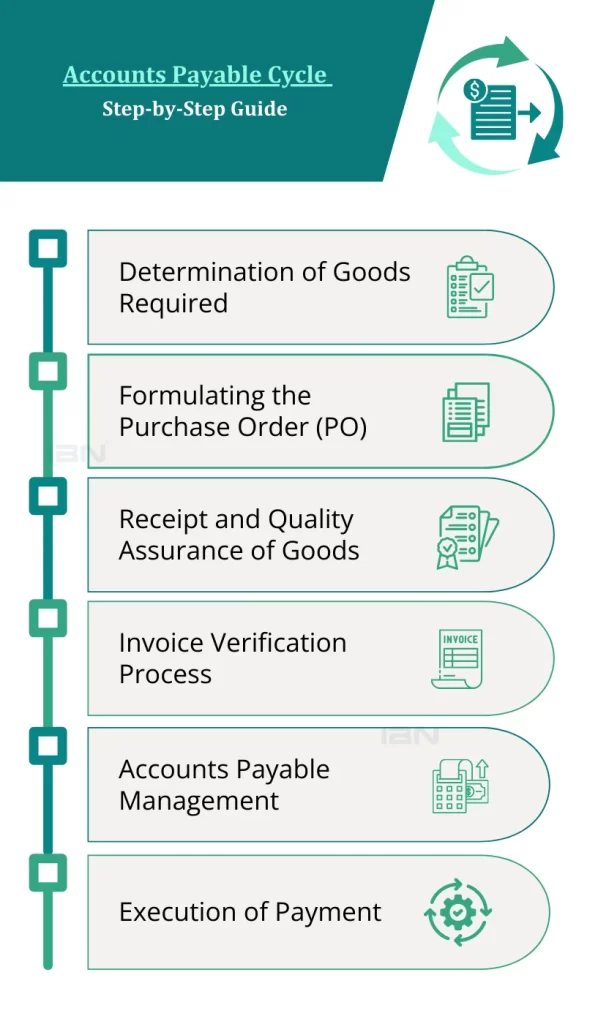
The Accounts Payable Cycle is one of the most important aspects of effective financial management in any organization. Establishing streamlined procedures for vendor payments and bill settlements is imperative, as it not only ensures optimal cash flow management but also fosters positive relationships with suppliers. Let’s explore the AP Cycle, focusing on key steps that will improve your organization’s efficiency and facilitate smooth payment processes.
Table of Contents
- 1. Account payable cycle: What it is?
- 2. Accounts Payable Cycle Step-by-Step Guide
- 3. Accounts Payable Cycle: Advantages and Disadvantages
- 4. How does IBN Tech enhance your business through AP cycle optimization?
- 5. Account Payable Cycle FAQs
Account payable cycle: What it is?
The full cycle of accounts payable refers to the complete range of activities managed by the Ap department, from the initial receipt and approval of invoices to the final stage of making payments to vendors. This encompassing account payable process plays a crucial role in the efficient management of a business’s financial transactions, ensuring smooth operational flow and financial stability.
Accounts Payable Cycle Step-by-Step Guide
In the realm of business finance, understanding the AP cycle is crucial. This cycle, often referred to as the procure-to-pay process, encompasses several key steps:

1. Determination of Goods Required
At the commencement of the AP cycle steps, it is essential to accurately determine the needs of your business, whether for production materials or marketing services. A responsible member from the concerned department initiates the process by completing a requisition form. This document specifies the required items, their quantities, and other relevant details. It undergoes a thorough internal review and approval process to ensure it is in line with the organization’s budget and strategic objectives, after which it is forwarded to the procurement team.
2. Formulating the Purchase Order (PO)
Upon approval of the requisition, the procurement team undertakes a critical role. They engage in a meticulous selection process of suppliers, evaluating factors like cost, quality, and dependability. Following successful negotiations, a Purchase Order (PO) is issued. This document serves as a legally binding agreement, specifying the details of the order.
3. Receipt and Quality Assurance of Goods
The arrival of goods marks a crucial phase where the receiving department conducts a detailed inspection. This process verifies that the goods received align with the specifications outlined in the PO. The department records these details and notifies the AP team, setting the stage for subsequent financial processing.
4. Invoice Verification Process
At this juncture, the AP department takes the lead. They receive and thoroughly review the supplier’s invoice, ensuring it corresponds with both the PO and the delivery documentation. Any discrepancies found are resolved at this stage. Following this, the invoice advances to the final stage of approval.
5. Accounts Payable Management
Once an invoice receives approval, it is logged as a liability in the company’s financial records under accounts payable management. The team responsible for accounts payable diligently preparing all required documentation for payment, ensuring thorough attention to detail for the upcoming payment procedure.
7. Execution of Payment
Concluding the AP cycle, the team executes the payment to the supplier using the chosen method of transaction. Following payment, the AP records are updated to reflect the settlement of the invoice, thus bringing the cycle to successful completion.
Accounts Payable Cycle: Advantages and Disadvantages
Overall, the ap cycle is highly beneficial for businesses when managed correctly, contributing to sound financial health.
How does IBN Tech enhance your business through AP cycle optimization?
This cycle is not just about financial compliance; it’s a crucial strategic tool that drives your business toward long-term success. Understanding and optimizing each step of this cycle ensures timely debt clearance and robust financial management.
At IBN Tech, our focus is on elevating your accounts payable process from a mere financial task to a key driver of business growth. We excel in customizing financial workflows to align with your specific requirements, converting potential obstacles into steppingstones for progress. Choosing our accounts payable outsourcing services means more than just streamlining finances; it’s about empowering your business to excel in a fiercely competitive market.
Automation of accounts payable (AP) can help you position yourself as a leader in your industry. IBN Tech offers access to cutting-edge technological solutions, including AP automation, within our array of proven strategies. Our expertise focuses on refining your financial operations, ensuring that your automated AP cycle becomes a central element in propelling your business towards success. Let us help you refine your financial processes, ensuring your Ap cycle is a driving force behind your business’s success.
Contact IBN Tech today to discover how our personalized solutions can propel your business to new heights. Let’s transform your entire payment processing cycle into a route for impressive growth and stability.
READ OUR LATEST PRESS RELEASE : – CONSTRUCTION PAYMENT CYCLES SLOW TO 94 DAYS ON AVERAGE, COSTING THE INDUSTRY BILLIONS
Account Payable Cycle FAQs
- Q.1 What is the Accounts Payable Cycle?
- The AP Cycle refers to the entire lifespan of a company’s payables, starting from the procurement of goods or services to settling corresponding invoices. It is crucial for maintaining cash flow, vendor relationships, and overall financial health.
- Q.2 What are the advantages of the AP cycle?
- Advantages include better cash management, improved customer relations, good financial reporting, and effective budgeting.
- Q.3 What are the stages in the AP cycle?
- The stages include receiving the invoice, reviewing the invoice, approving the invoice, and finally paying for invoice.

